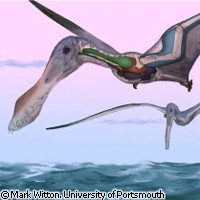How prehistoric reptiles took flight
How the flying reptiles, the pterosaurs, were able to cope with the high energy requirements for air travel was, until now, a mystery. A UK-US group of researchers has, however, successfully pieced together this puzzle. Their findings were recently published in the journal PLoS ONE. Pterosaurs filled the skies 70 million years before birds took flight, during the Mesozoic Era. While some people believe they were dinosaurs, the truth is that they weren't, but they were closely related. Dinosaurs were, by definition, diapsid reptiles with an upright stance, while pterosaurs probably had a semi-upright stance. Growing to the size of a small aircraft in some cases, researchers were puzzled as to how these large reptiles were able to soar in the air. What is clear is that the pterosaurs powered their flight by flapping their large wings, which reached up to 10 metres in wingspan and consisted of membranes of skin and other tissues, as well as actinofibrillae (i.e. closely spaced fibres). According to the researchers, the pterosaurs were equipped with balloon-like air sacs that extended from the lungs throughout the body and, as with modern-day birds, hollow bones. This provided these wondrous reptiles with an efficient breathing system and the researchers determined that the pneumatised skeletal system and air sacs effectively lessened their density, ultimately helping them to take flight. 'We have identified the breathing system of a pterosaur,' explained Dr Dave Unwin, a palaeobiologist in the Department of Museum Studies at the University of Leicester in the UK, and co-author of the study. 'It's a surprisingly efficient mechanism with the same essential structure of a modern bird's lung apparatus - except 70 million years earlier.' The study became a reality following a visit by Assistant Professor Leon Claessens from the College of the Holy Cross in the US and Assistant Professor Patrick O'Connor from Ohio University's College of Osteopathic Medicine in the US to the German capital of Berlin nearly six years ago where they observed a well-preserved rib cage of a pterosaur. Professor Unwin also saw the fossil when he was the curator of the Museum für Naturkunde in Berlin in 2003. The three palaeobiologists then decided to work together to find out how these huge reptiles were able to power sustained flapping in flight. 'The shape and size of the rib segments that articulate with the sternum [sternal ribs] show that, contrary to what was previously thought, the rib cage was mobile,' Assistant Professor Claessens said, adding that the 'unique and previously unrecognised projections on the sternal ribs provided important leverage for the muscles that moved the ribcage'. The researchers also compared pterosaur specimens with modern bird skeletons in order to gain more insight into the relationship between the air sacs, lung structure and skeleton. The team used CT scans and X-rays to get a better visual of the bones. 'The air sacs extend all the way to the tips of the wings which opens up a wide range of possibilities for the use of air sacs during flight and for social behaviours,' the researchers said. 'We found a direct relationship between the proportion of the skeleton invaded by air sacs and the absolute body size of an animal,' they added. In a nutshell, the smaller the birds, the fewer the pneumatised bones they have. This is due to their lower weight and the fact that they need to spend less energy in flight. As regards large-sized birds like the pterosaurs, their bones are pneumatised, giving them less bone density but making it easier for them to sustain their bodies in flight.
Countries
United Kingdom, United States



